本文由 杭州园林设计院股份有限公司 授权mooool发表,欢迎转发,禁止以mooool编辑版本转载。
Thanks Hangzhou Landscape Architecture Design Institute Co., Ltd. for authorizing the publication of the project on mooool, Text description provided by Hangzhou Landscape Architecture Design Institute Co., Ltd..
杭州园林设计院股份有限公司:河流与城市,往往是共生共荣的关系。很多城市都有一条“母亲河”,承担着城市居民饮用水源、农业灌溉以及工业发展的需求。长期以来,河流哺育了城市,但城市并未反哺河流。相反,城市的发展扩张,往往会带来污染,河道被侵占和生态资源的衰退,造成水土流失、雨洪灾害和水资源危机等问题频发。
Hangzhou Landscape Architecture Design Institute Co., Ltd.: Rivers and cities are often in a symbiotic relationship. Many cities have a “mother river” that bears the needs of urban residents for drinking water, agricultural irrigation and industrial development. For a long time, rivers have fed cities, but cities have not fed rivers back. On the contrary, the development and expansion of cities often brings pollution, encroachment of river channels and decline of ecological resources, resulting in frequent occurrence of problems such as soil erosion, rain and flood disasters and water resource crises.
▽湿地西向鸟瞰 Aerial view of west part
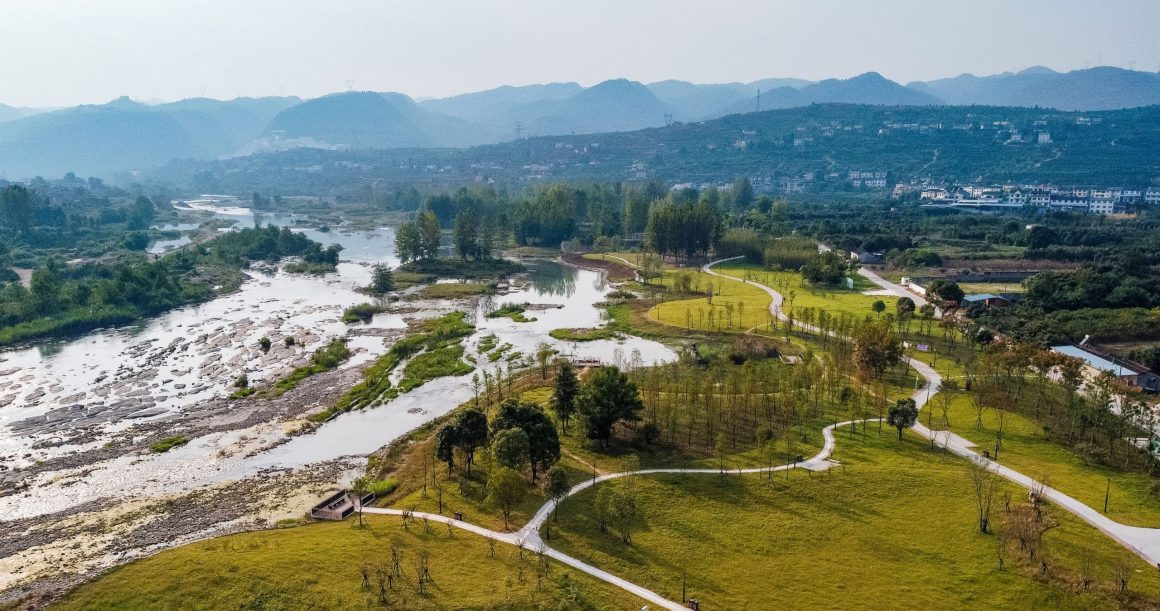
▽湿地东向鸟瞰 Aerial view of east part
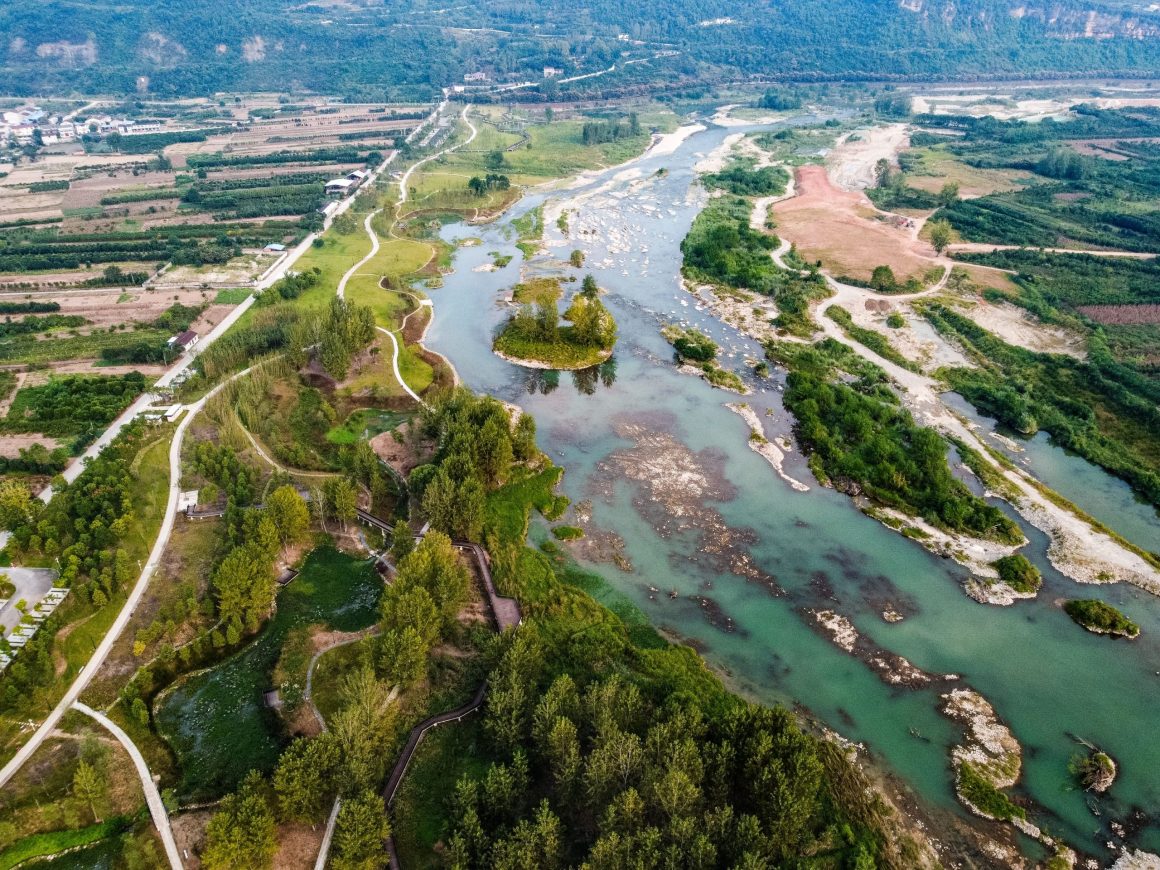
近年来,随着环保理念深入人心,城市与河流的矛盾逐步得到缓解。决策者也越发重视对河流的保护,将原本属于河流的空间退让出来,还与自然,还与市民。本项目便是一个典型的案例。
In recent years, with the popularization of the concept of environmental protection, the contradiction between the city and the river has been gradually eased. Policy makers are also paying more and more attention to the protection of rivers, relinquishing the space that originally belonged to the river, and returning it to nature and citizens. This project is a typical case.
项目概况 Project Overview
基地位于宜昌市夷陵区黄柏河沿线,分为两段,分别位于下坪村和蔡家河村附近河滩,总面积约154公顷,其中水域面积约35公顷。其紧邻的南蔡下片区是未来宜昌城市向北拓展的核心,城市与河流关系密切。
The project is located along the Huangbai River in Yiling District, Yichang City. It is divided into two sections, located in Xiaping Village and Caijiahe Village, with a total area of about 154 hectares, of which the water area is about 35 hectares. The adjacent Nancaixia area is the core of the future northward expansion of Yichang city, and the city is closely related to the river.
▽场地现状遍布采石挖沙痕迹和农田菜地,极易造成水土流失和面源污染 The current situation of the site is all over the quarry sand excavation traces and vegetable fields, easy to cause soil erosion and non-point source pollution
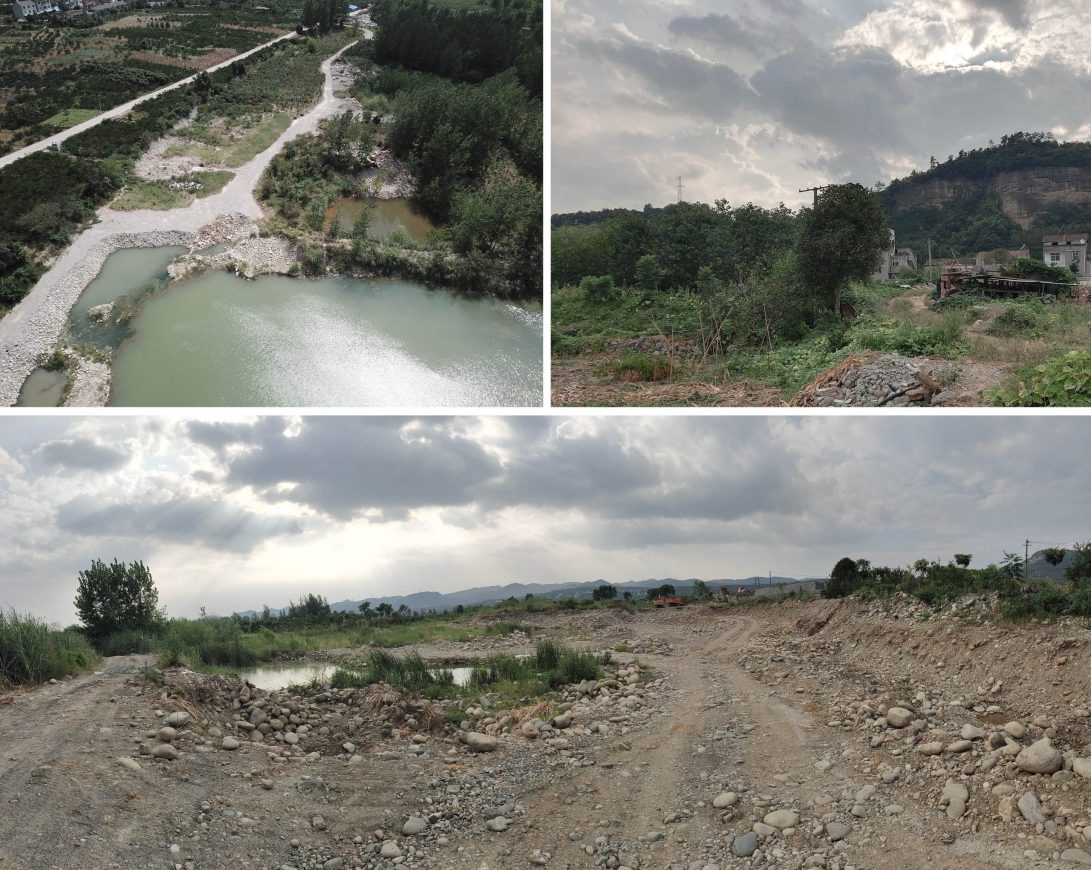
黄柏河是长江一级支流,河流全长162km,下游段流经宜昌市区,承担着为宜昌城区及宜东地区200万人口和100万亩农田供水的重任,供水区域内经济总量约占全市的80%,被誉为宜昌的“母亲河”。黄柏河河道平均坡度3.76 ‰,两岸山势陡峭,属于典型的山溪型河流。与平原型河流不同,前者季节性特征明显,汛期短时间内可汇集大量地表径流,且流速大,挟沙能力和冲刷能力很强;而在旱季,则水量骤减,部分河床裸露。
The Huangbai River is a first-class tributary of the Yangtze River, with a total length of 162km. The downstream section flows through the urban area of Yichang. It undertakes the important task of supplying water to 2 million people and 1 million mu of farmland in the urban area of Yichang and Yidong. The total economic volume in the water supply area accounts for about 80% of the city is known as the “Mother River” of Yichang. The average slope of the Huangbai River is 3.76 ‰, and the mountains on both sides are steep, which is a typical mountain stream type river. Different from plain rivers, the former has obvious seasonal characteristics. In the flood season, a large amount of surface runoff can be collected in a short period of time, and the flow rate is large, and the sand carrying capacity and scouring capacity are strong; in the dry season, the water volume decreases sharply, and part of the riverbed is exposed.
▽主河道水流较湍急,特别汛期时易冲刷裸露土壤,造成水土流失 The main river flow is rapids, special flood season easy to wash bare soil, resulting in soil erosion
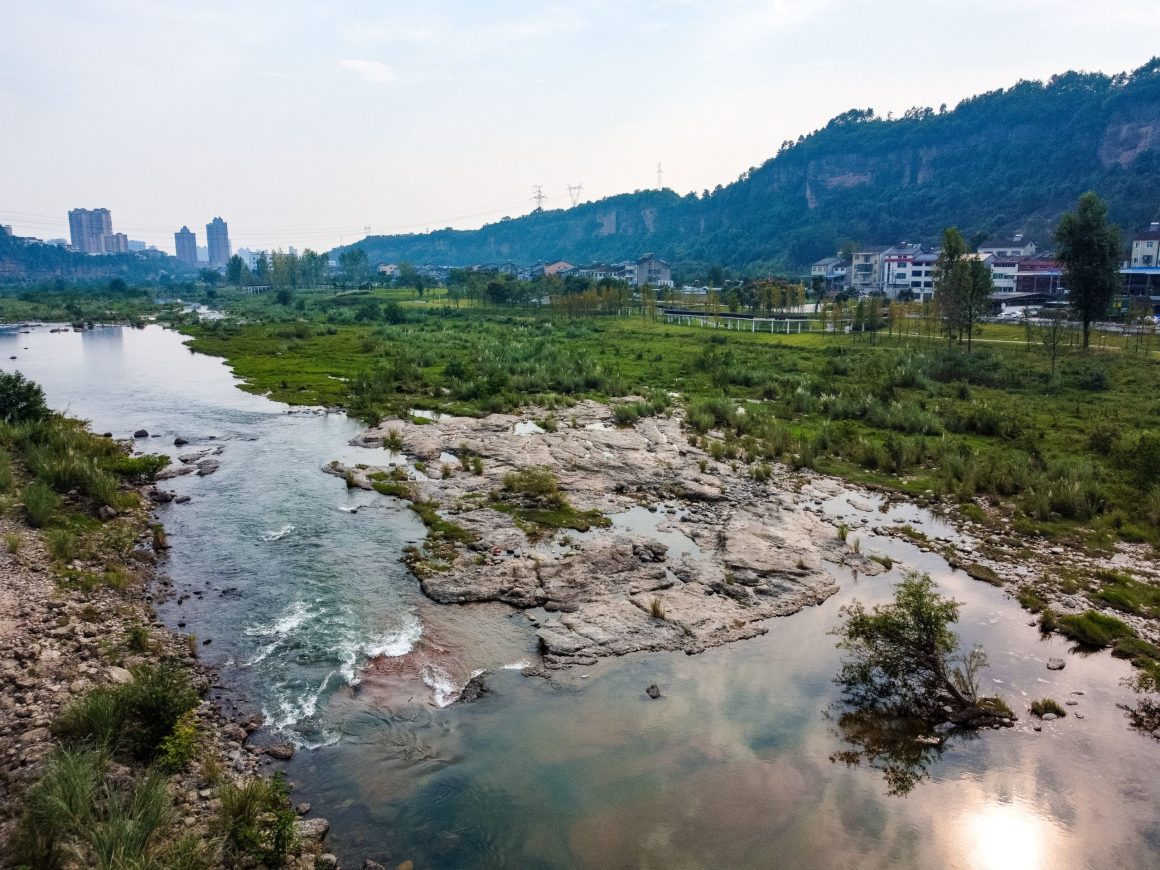
▽枯水期河床裸露 River bed exposed during dry season
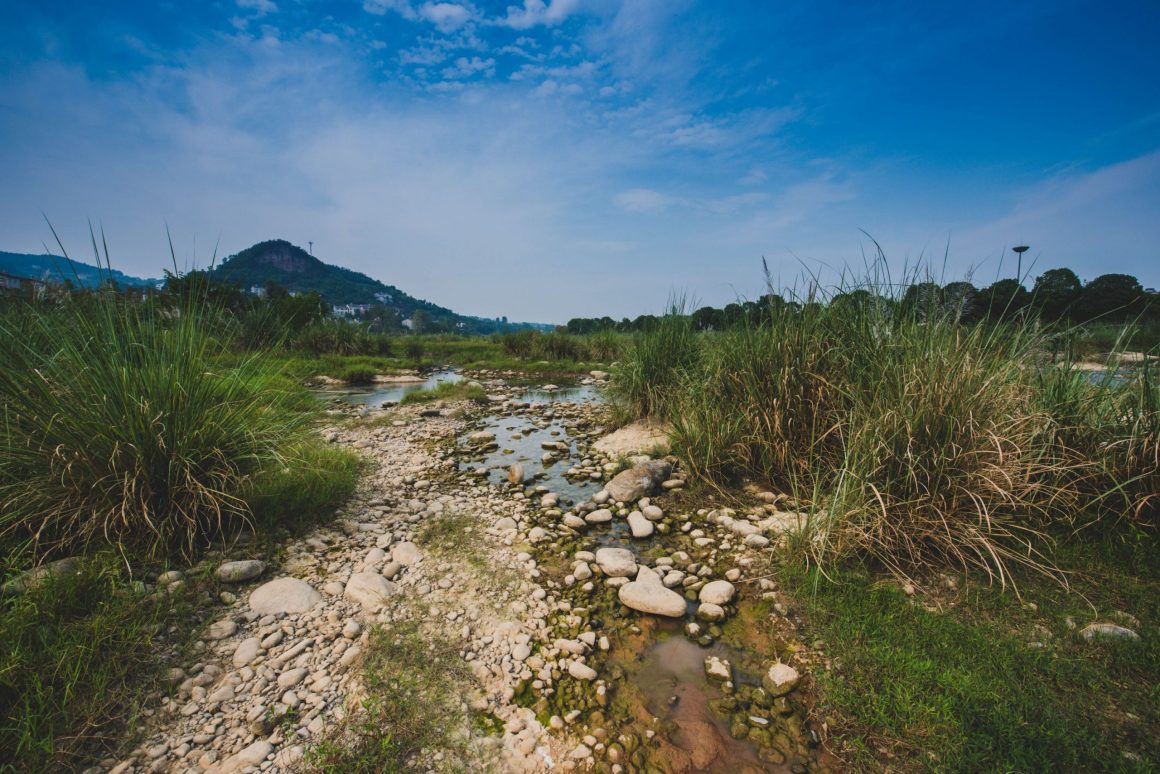
项目区域是黄柏河流经宜昌市区范围仅有的两段河流漫滩湿地,河道在此陡然变宽,承担着调蓄雨洪、为生物提供栖息地等重要作用。湿地现状保留着较为原始的自然基底,存在大面积的滩涂、池塘,部分区域有成片自然林木长势较好,但因历史原因,场地内遗留了大量的采石挖沙遗迹,坑塘密布,土石裸露,自然植被遭到破坏,且存在大量工棚、废弃厂房、菜地等人工设施,对自然风貌和生态价值带来很大负面影响。
The project area is the only two floodplain wetlands of the Huangbai River passing through the urban area of Yichang, where the river suddenly widens and plays an important role in regulating stormwater and providing habitats for living things. The status quo of the wetland retains a relatively primitive natural base, with large areas of tidal flats and ponds, and some natural forests grow well in some areas. The soil and rocks are exposed, the natural vegetation is destroyed, and there are a large number of artificial facilities such as sheds, abandoned factories, vegetable fields, etc., which have a great negative impact on the natural style and ecological value.
▽东侧鸟瞰可见对岸未修复区域挖沙痕迹明显,土石裸露 The east side of the bird’s eye view can be seen on the other side of the unrepaired area dredging sand traces, bare soil and stone
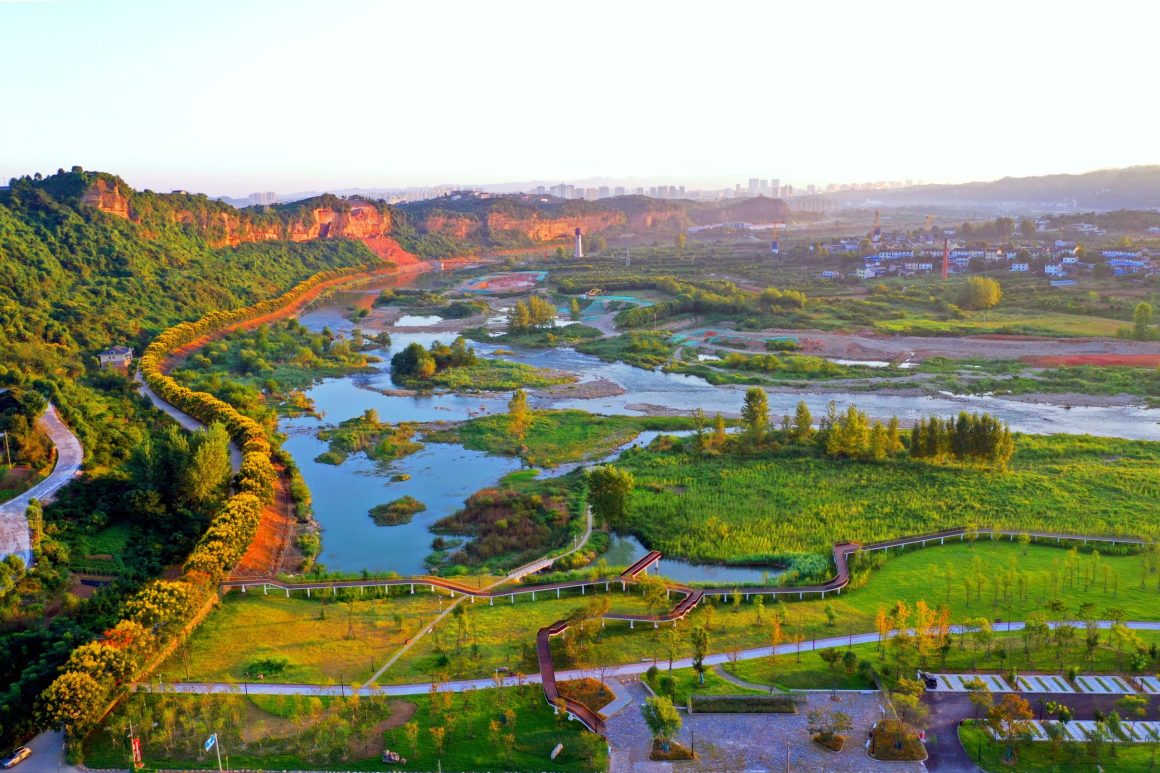
设计策略——生态优先,最小干预 Design Strategy – Ecology First, Minimal Intervention
项目从本质上是一个生态修复工程,其首要目的是保护并修复黄柏河流经宜昌市区范围内的河滩湿地,使其更好的发挥生态功能。因此在设计之初,即明确了将生态修复放在第一位,“公园”属性放在第二位的原则。即减少对湿地的人为破坏干扰,恢复植被,营造适宜各类湿地生物特别是鸟类的生境,使其能够在此生息繁衍。其次才是人的需求,即在此基础上增加公园设施,满足市民活动需要。
The project is essentially an ecological restoration project, and its primary purpose is to protect and restore the floodplain wetlands of the Huangbai River flowing through the urban area of Yichang, so that it can better play its ecological function. Therefore, at the beginning of the design, the principle of putting ecological restoration first and “park” attributes second. That is to reduce the human damage and disturbance to the wetland, restore the vegetation, and create a suitable habitat for all kinds of wetland organisms, especially birds, so that they can live and reproduce here. The second is the needs of people, that is, to increase park facilities on this basis to meet the needs of public activities.
▽将挖沙遗留坑塘沟通串联,生态修复后形成海绵体系 The excavation of sand left by the pit and pond communication series, ecological restoration after the formation of sponge system

最小干预策略,对自然而言,是指尽量不干扰湿地原生区域风貌,如湿地内现状原生乔木尽可能保留,如与设计产生冲突优先调整设计等。对人而言,是指应划定人为活动的边界,同时修复已遭破坏的湿地风貌。
The minimal intervention strategy, for nature, refers to not disturbing the original area of the wetland as much as possible, such as retaining the existing native trees in the wetland as much as possible, and prioritizing the design if there is a conflict with the design. For people, it means that the boundaries of human activities should be demarcated, and the damaged wetlands should be restored.
▽总平面图 Plan

总体设计——基于雨洪分析基础上的分级、梳理与建构Master plan – classification, sorting and construction based on stormwater analysis
雨洪分析——总体设计的先决条件
Stormwater analysis – a prerequisite for master plan
黄柏河属山溪型河流,汛期和旱季水位落差巨大,且设计范围均位于水利部门所划定的河道内,汛期时集水速度快,流量大且流速快,破坏力很强。因此雨洪因素是设计需首先考虑的问题,需充分了解哪些区域是汛期可能会淹没的,哪些是较为安全的,从而为总体设计及景观设施的布置提供依据。
Huangbai River is a mountain stream type river with huge water level difference between flood season and dry season, and the design range is located in the river channel delineated by the water conservancy department. Therefore, the rain and flood factor is the first consideration in the design. It is necessary to fully understand which areas may be submerged during the flood season and which are relatively safe, so as to provide a basis for the overall design and the layout of landscape facilities.
▽洪水位淹没范围综合分析-蔡家河段湿地 Comprehensive analysis of inundation range of flood level – Caijia River
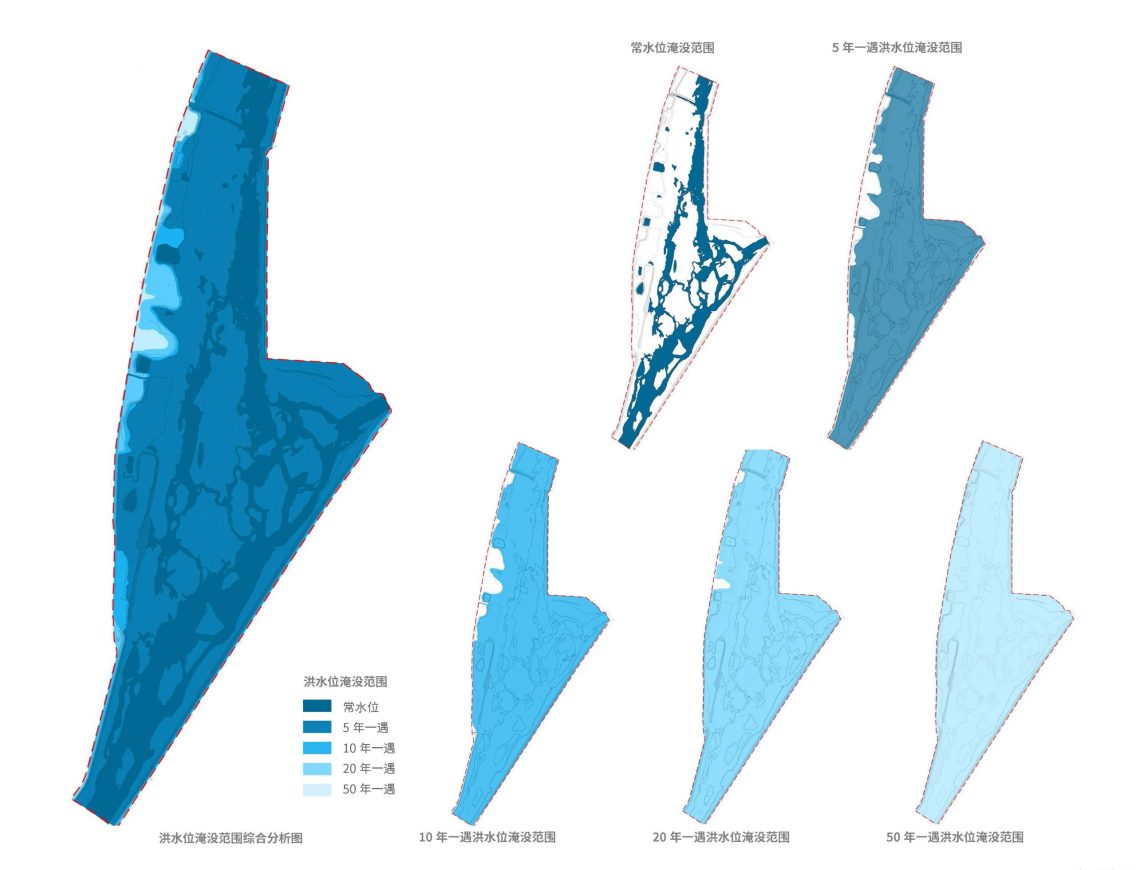
▽洪水位淹没范围综合分析-下坪段湿地 Comprehensive analysis of flood level inundation range – Xiaping section
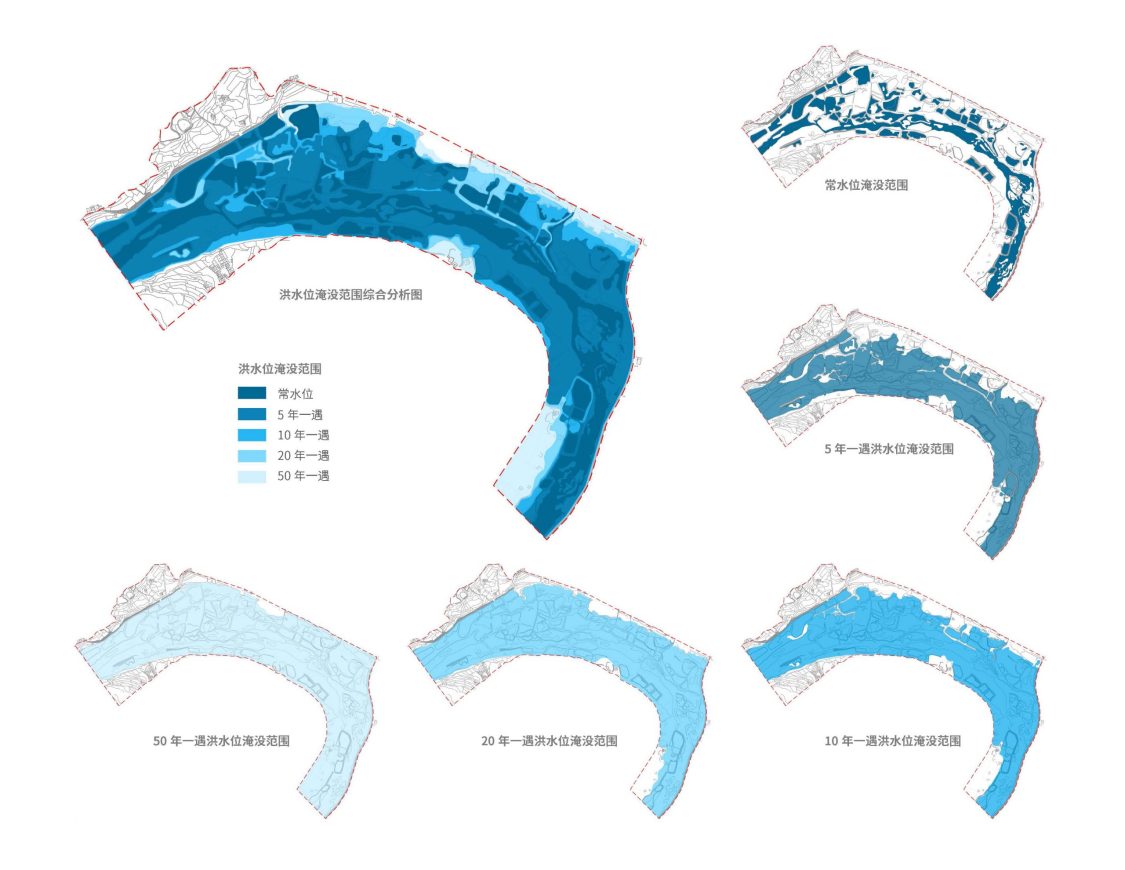
依据水利部门所测得的各监测点水文资料,综合现状测绘地形图的标高数据,可以划出5年一遇、10年一遇、20年一遇和50年一遇的洪水位淹没范围。设计标高虽较现状地形有所调整,但总体影响不大,后续各项分析布局均建立在此基础上。
According to the hydrological data of each monitoring point measured by the water conservancy department, and the elevation data of the current surveying and mapping topographic map, the flood level inundation range of once in 5 years, once in 10 years, once in 20 years and once in 50 years can be delineated. Although the design elevation has been adjusted compared with the current topography, the overall impact is not large, and the subsequent analysis and layout are based on this basis.
▽蔡家河段湿地常水位与洪水位对比-等级约5年一遇,已将绝大部分河滩淹没,仅西岸部分高地露出水面Comparison of normal and flood water levels in Caijia Reach wetland

▽下坪段湿地常水位与洪水位对比-等级约5年一遇,主河道区域已大部分淹没,北侧河滩也部分淹没 Comparison of normal water level and flood water level in Xiaping section of wetland
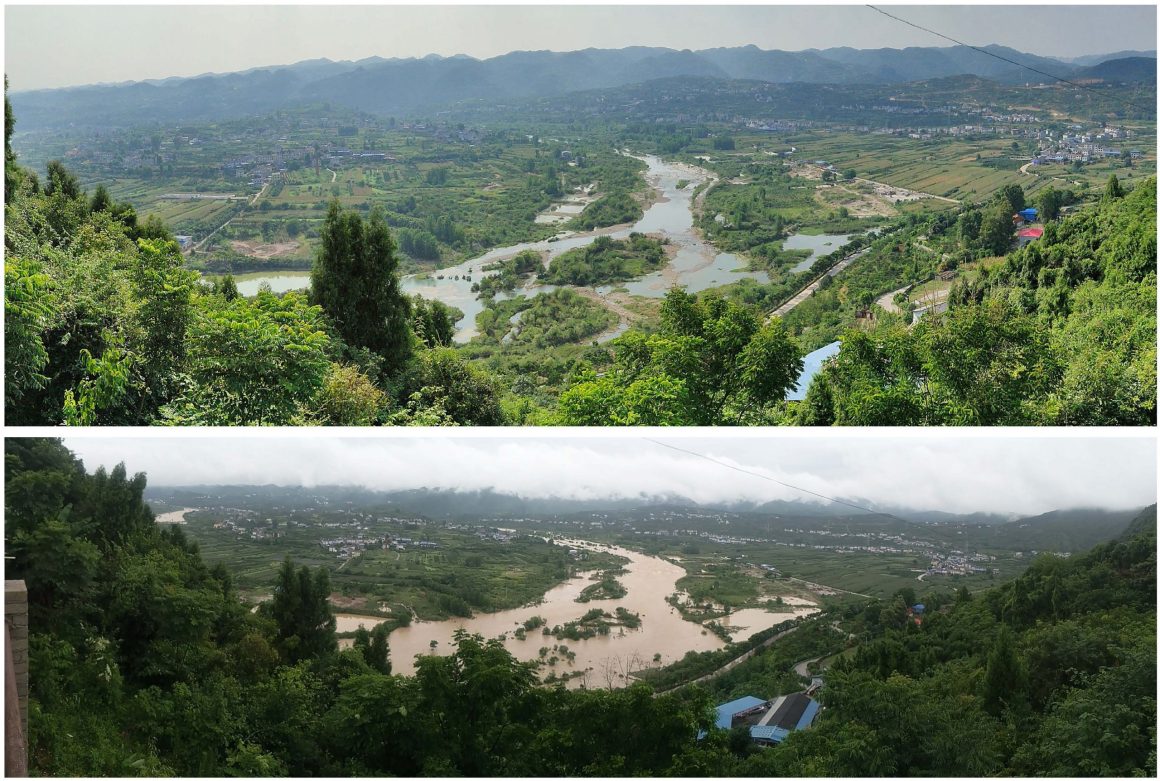
划定保护分级——规避过度干预
Delineation of protection levels – avoiding excessive intervention
湿地按保护程度和人工干预强度可划分为三个级别保护区,其中:
一级保护区覆盖黄柏河主河道,完整保留现状风貌不做干预,游客不能进入。
二级保护区内主要以疏通水系,修复植被为主,除设置部分高架栈桥外不设地面道路和活动场地,人为干预较少。
三级保护区位于最外围,是湿地公园的主要活动区。在此区域内通过自然的手法梳理地形,营造绿地,设置园路和活动场地等,并布置有少量服务建筑,总体开发强度较低。
The wetland can be divided into three levels of protected areas according to the degree of protection and the intensity of human intervention, of which:
The first-class protected area covers the main channel of Huangbai River, and the existing features are completely preserved without intervention, and tourists are not allowed to enter.
The secondary protection zone mainly focuses on dredging the water system and restoring vegetation. Except for some elevated trestle bridges, there are no ground roads and activity venues, and there is less human intervention.
The third-level protected area is located at the outermost periphery and is the main activity area of the wetland park. In this area, natural methods are used to sort out the terrain, create green space, set up garden roads and activity venues, etc., and arrange a small number of service buildings, and the overall development intensity is low.
设施布局——营造舒适安全的活动空间
Facility layout – create a comfortable and safe activity space
因水利部门要求,项目范围内不能出现影响行洪的设施。设计在前述雨洪分析的基础上,结合洪评要求,确定可建设范围、设施和高程控制范围。首先设置了连续的高架栈道系统,面层标高控制在在20年一遇洪水位以上,其上供游客穿行,其下不影响行洪。
Due to the requirements of the water conservancy department, there should be no facilities that affect flood discharge within the project scope. The design is based on the aforementioned rainwater analysis and combined with the flood assessment requirements to determine the construction scope, facilities and elevation control scope. First of all, a continuous elevated plank road system is set up, and the elevation of the surface layer is controlled above the flood level once in 20 years. The upper part is for tourists to walk through, and the lower part does not affect the flood flow.
▽栈桥面层高于20年一遇洪水位 The trestle surface is higher than the flood level in 20 years
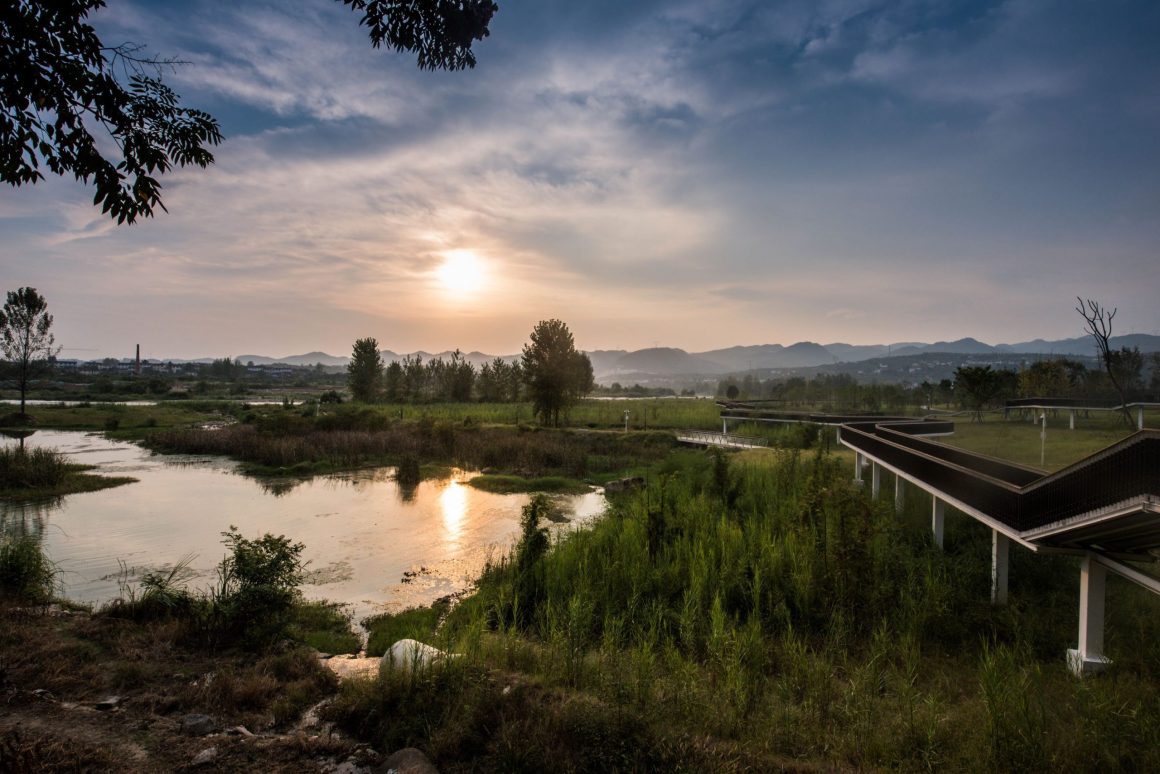

▽高架栈桥穿梭于林间,汛期时不致淹没 Viaduct trestle shuttle between the forest, flood season is not submerged

栈道或在林中穿梭,或架于湿地水面,给予游人丰富的游赏和观景体验。在地面设置各级慢行步道、串联主要游赏区域,与上层高架栈道形成了立体交叉网络。
The plank road can travel through the forest, or stand on the wetland water surface, giving visitors a rich experience of sightseeing and viewing. All levels of slow walking trails are set up on the ground, connecting the main tourist areas in series, and forming a three-dimensional cross network with the upper elevated plank road.
▽高架栈桥于林间穿梭,与地面道路立体交叉 Viaduct trestle shuttle between the forest, and the ground road three-dimensional intersection

▽栈道在林间穿梭,得益于原生林木的保留,形成高大的林冠线 The boardwalk shuttles through the forest, benefiting from the preservation of native trees, forming a tall canopy line
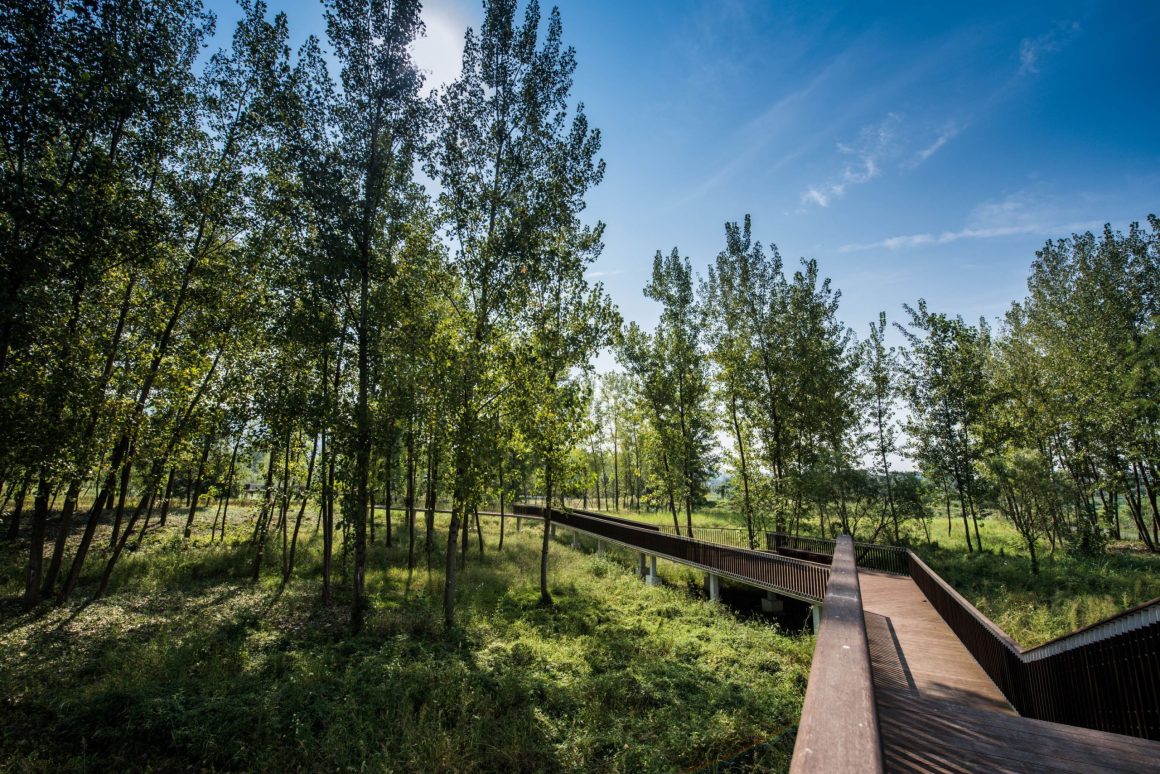
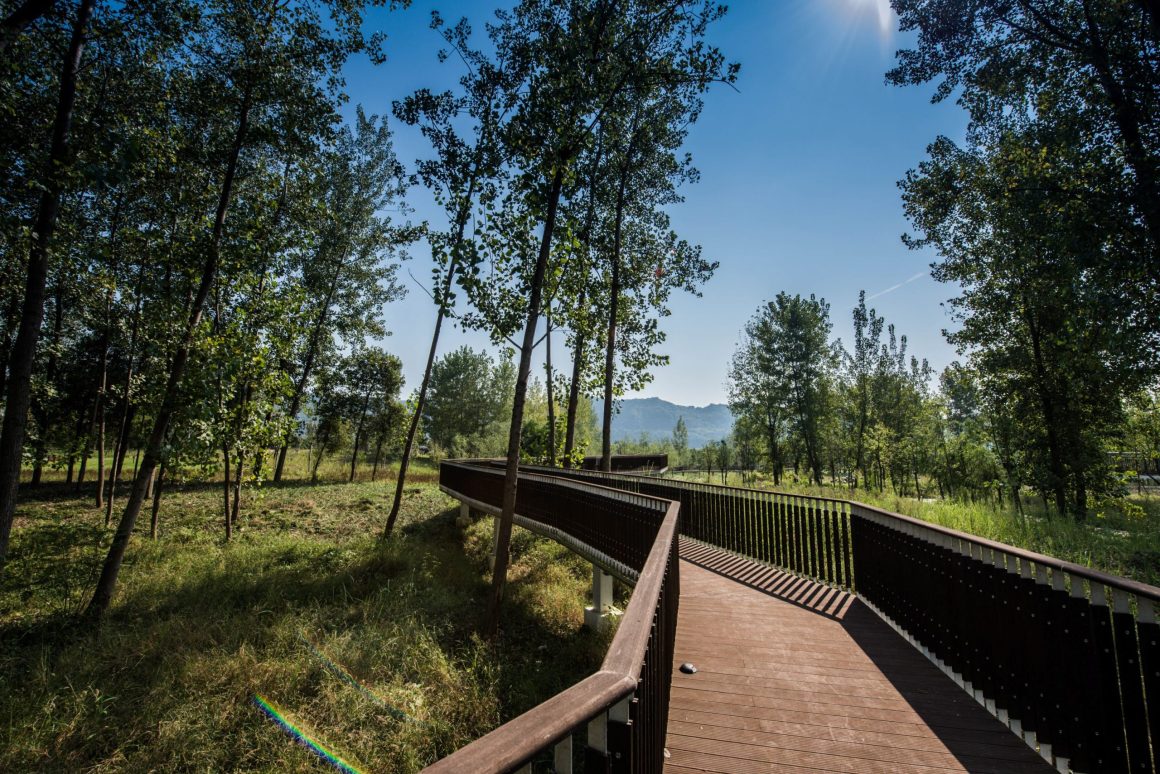
同时结合服务建筑、观鸟屋、生态停车场、亲水平台等设施,其中建筑首层标高控制在50年一遇洪水位以上,主园路绝大多数在10年一遇洪水位以上,其余小径、亲水平台等均为可淹没设施,可适当亲水。整体设计在充分尊重现状风貌的基础上力求打造一处集湿地保护、观景、科普、休闲游憩于一体的生态湿地公园。
At the same time, combined with service buildings, bird watching houses, ecological parking lots, hydrophilic platforms and other facilities, the elevation of the first floor of the building is controlled above the 50-year flood level, and most of the main garden roads are above the 10-year flood level. Trails, hydrophilic platforms, etc. are all submersible facilities, which can be properly hydrophilic. The overall design strives to create an ecological wetland park that integrates wetland protection, viewing, popular science, and leisure on the basis of fully respecting the current situation.
▽林间的嵌草石板路 A grassy flagstone path through the woods

▽标高较低的园路保证了亲水效果,汛期可淹没 The lower elevation of the park road to ensure the hydrophilic effect, flood season can be submerged
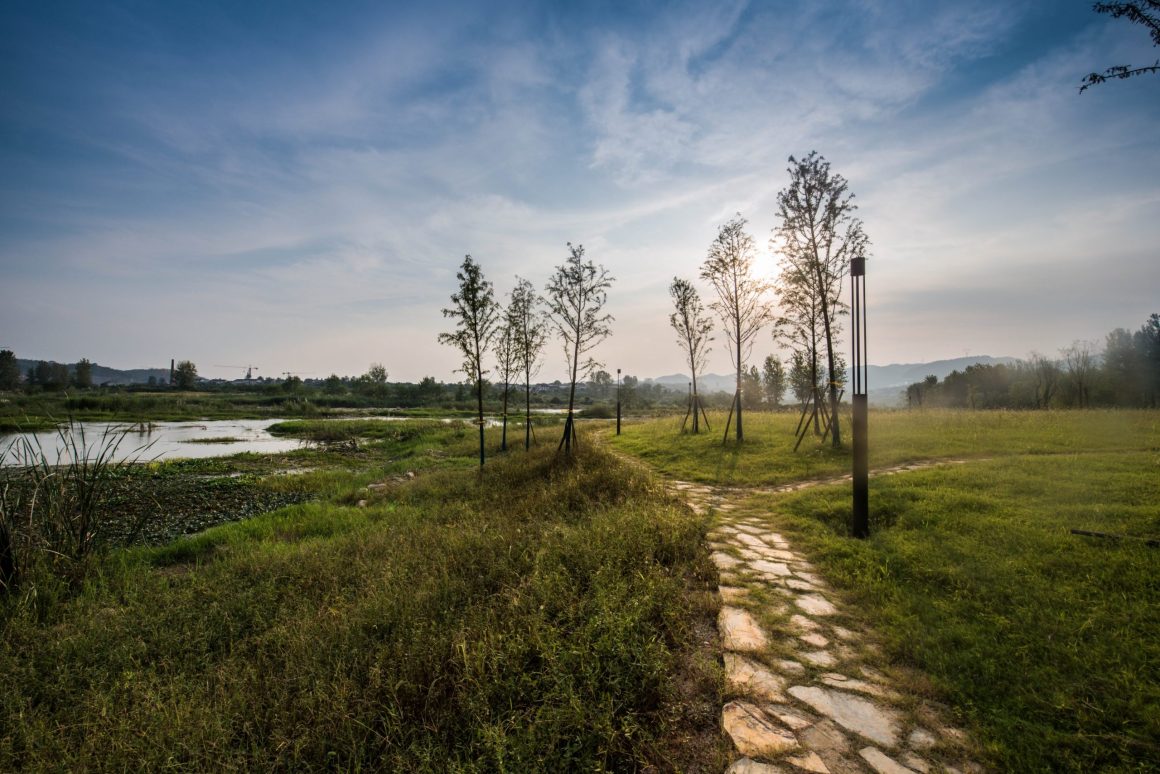
▽生态停车场 Ecological parking lot
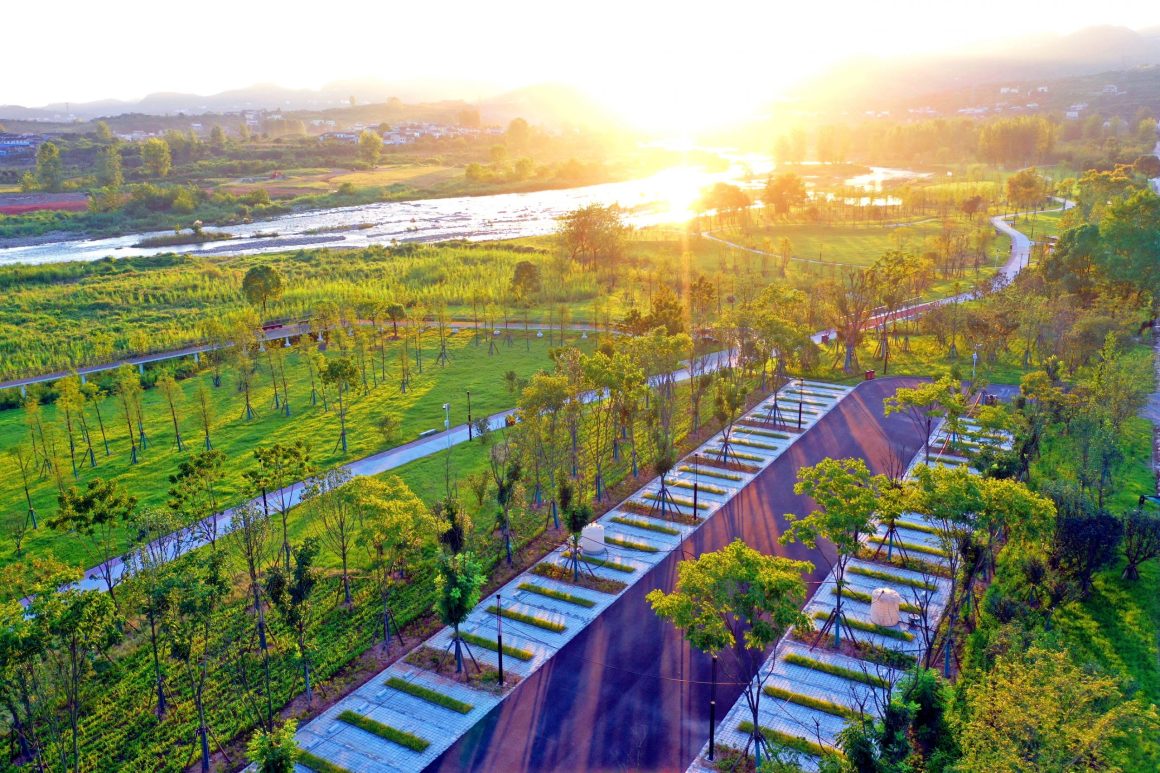
梳理水系——沟通互连,营造韧性景观
Sorting out the water system – communication and interconnection, creating a resilient landscape
基地现状主河道周边自然基底较好,未经人为干扰破坏,存在自然形成的浅滩沙洲和植被,可见水鸟栖息,设计对此予以完整保留,设为生态保育区。对主河道外侧挖沙遗留的坑塘等进行疏浚、沟通串联,使各坑塘水系和主河道之间能够互相连通,同时恢复湿地植被,使其变身为一系列的雨水花园,暴雨时可承接周边汇水,一定程度上减缓向主河道排放,在上游来洪时也可消减流量,增加汛期雨洪调蓄能力。原有坑塘驳岸较陡,设计在一定程度上改造岸线和水深,使水体形态更为自然,同时在保证近岸安全水深要求。
The natural base around the main river channel of the base is relatively good, and it has not been damaged by human interference. There are naturally formed shoal sandbars and vegetation, and waterbirds can be seen inhabiting. This is completely preserved and designated as an ecological conservation area. The pits and ponds left by sand excavation outside the main channel are dredged, communicated and connected in series, so that the water systems of the pits and the main river can be connected with each other, and the wetland vegetation is restored to transform it into a series of rain gardens, which can be used in heavy rains. Undertake the surrounding catchment, slow down the discharge to the main river to a certain extent, and also reduce the flow when the upstream floods, and increase the rainwater storage capacity during the flood season. The original pit and pond revetment is relatively steep, and the design changes the shoreline and water depth to a certain extent, so that the water body shape is more natural, and at the same time, it ensures the safe water depth requirements near the shore.
▽河滩中央树丛远离游客活动区,有鸟类做窝栖息 The trees in the middle of the beach are far away from the tourist area, and there are birds nesting
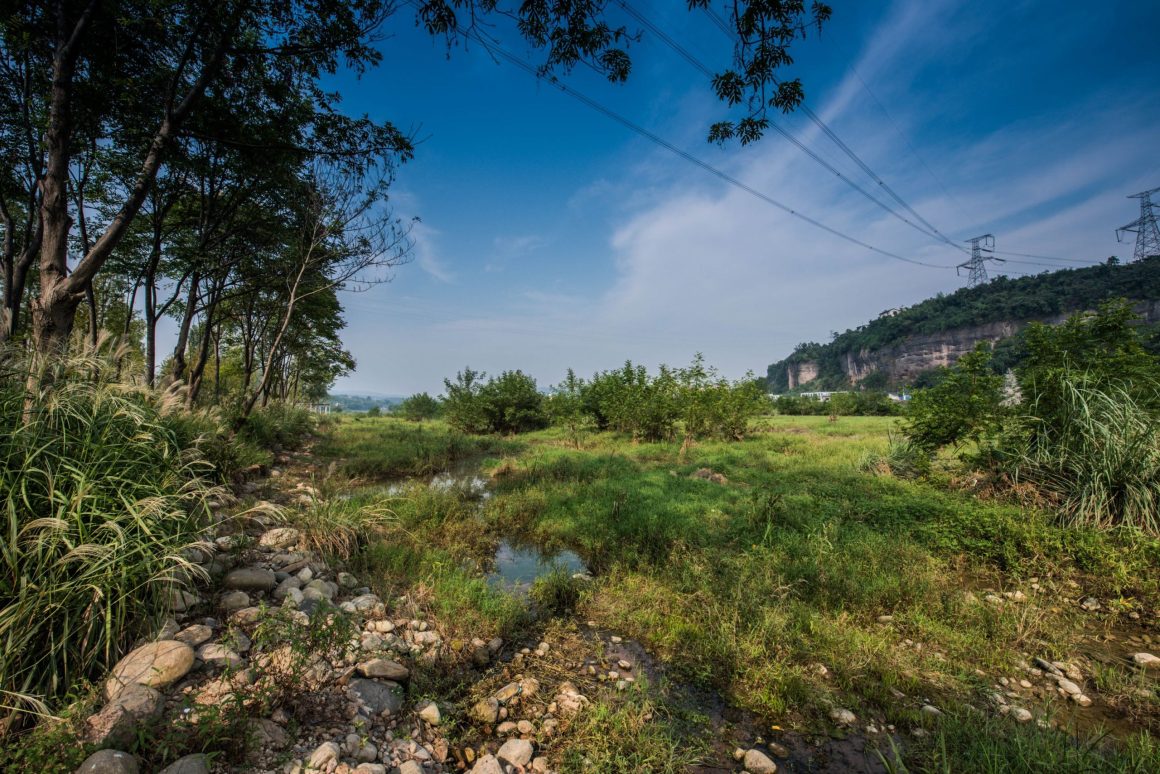
▽利用现状凹地,形成多处小型雨水花园,承接周边汇水 Using the current sunken land, the formation of a number of small rain gardens, to undertake the surrounding catchment
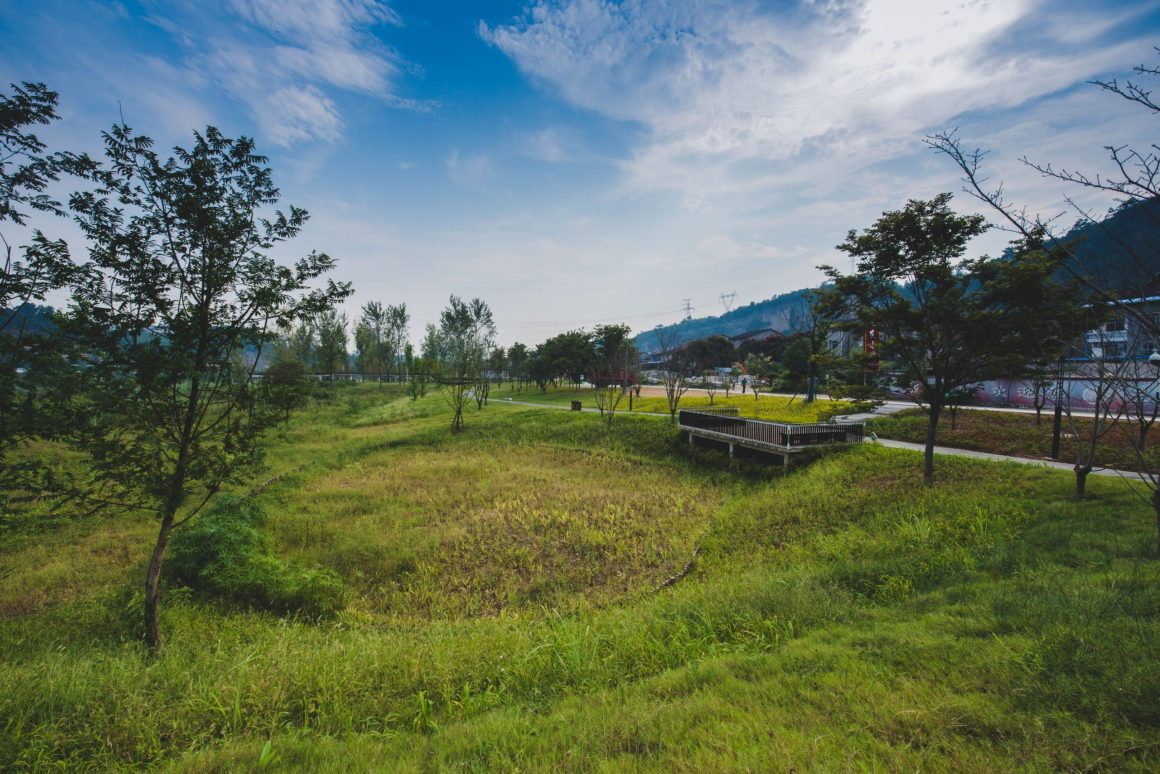
▽挖沙遗留坑塘修复后变身为湿地的一处秘境 Excavation of sand left after the repair of a wetland turned into a secret environment
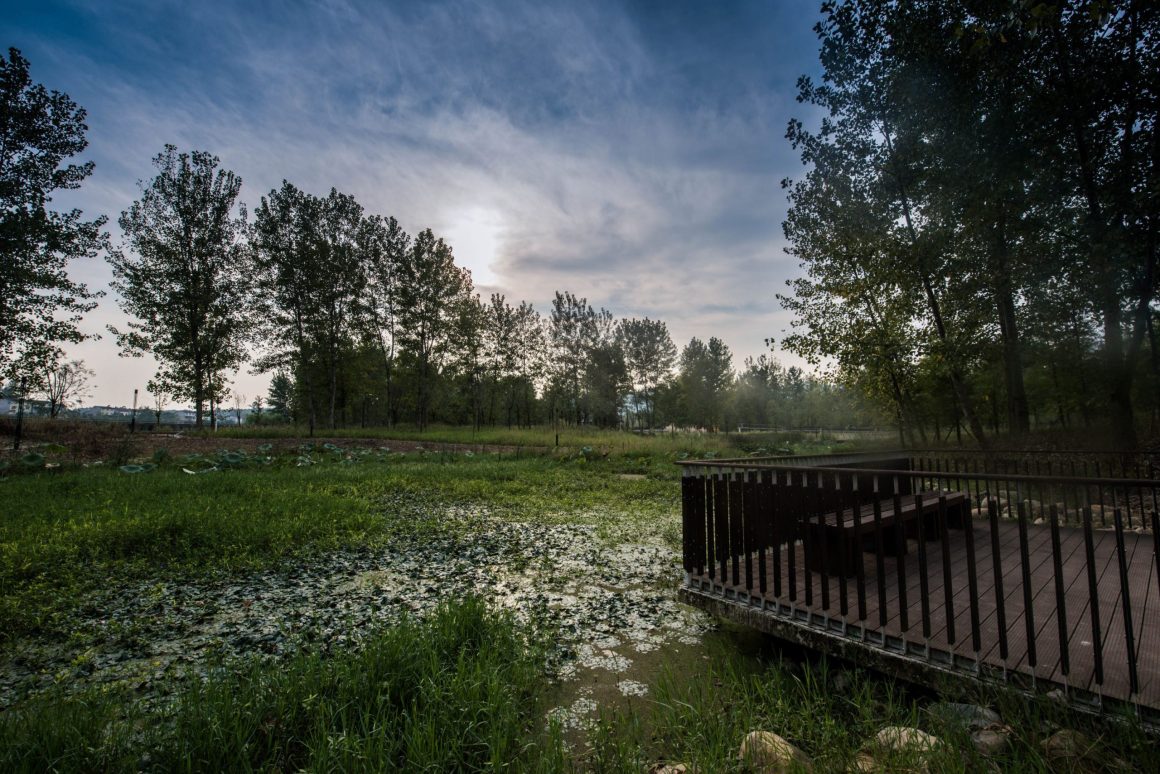
植物配置——原生植被的力量
Plant Design – The Power of Native Vegetation
基地现状存在大量原生植被,其中不乏长势良好的高大乔木,是维护生物多样性和景观营造的中坚。设计要求尽可能的保留现状乔木,特别是达到一定高度和冠幅的乔木做到100%保留。因场地范围较大,测绘图中现状植物信息也不够准确,设计图纸无法精确的避让所有原生乔木。因此在施工交底以及施工过程中,关于此问题各方进行及时有效的沟通尤为重要,现状乔木存在与设计园路、栈道等走线冲突时优先调整设计,从而最终成功使现状所有胸径10cm以上乔木得到完整保留,另外根据宜昌当地气候特征和湿地类项目特点,选取了多种乡土植物和适生湿地植被,提高区域生物多样性。
There are a lot of native vegetation in the current situation of the base, among which there are many tall trees with good growth, which are the backbone of maintaining biodiversity and creating landscape. The design requires that the existing trees be preserved as much as possible, especially the trees that reach a certain height and crown width should be 100% preserved. Due to the large scope of the site, the current plant information in the survey drawing is not accurate enough, and the design drawings cannot accurately avoid all native trees. Therefore, in the construction disclosure and construction process, it is particularly important for all parties to communicate on this issue in a timely and effective manner. When there is a conflict between the current arbor and the design of the road, plank road, etc., the design is given priority, so as to finally successfully make all the arbor with a diameter of more than 10cm at breast height. It has been completely preserved. In addition, according to the local climate characteristics and wetland project characteristics in Yichang, a variety of native plants and suitable wetland vegetation have been selected to improve the regional biodiversity.
▽植物风貌野趣,富有生机 The plants are wild and full of vitality
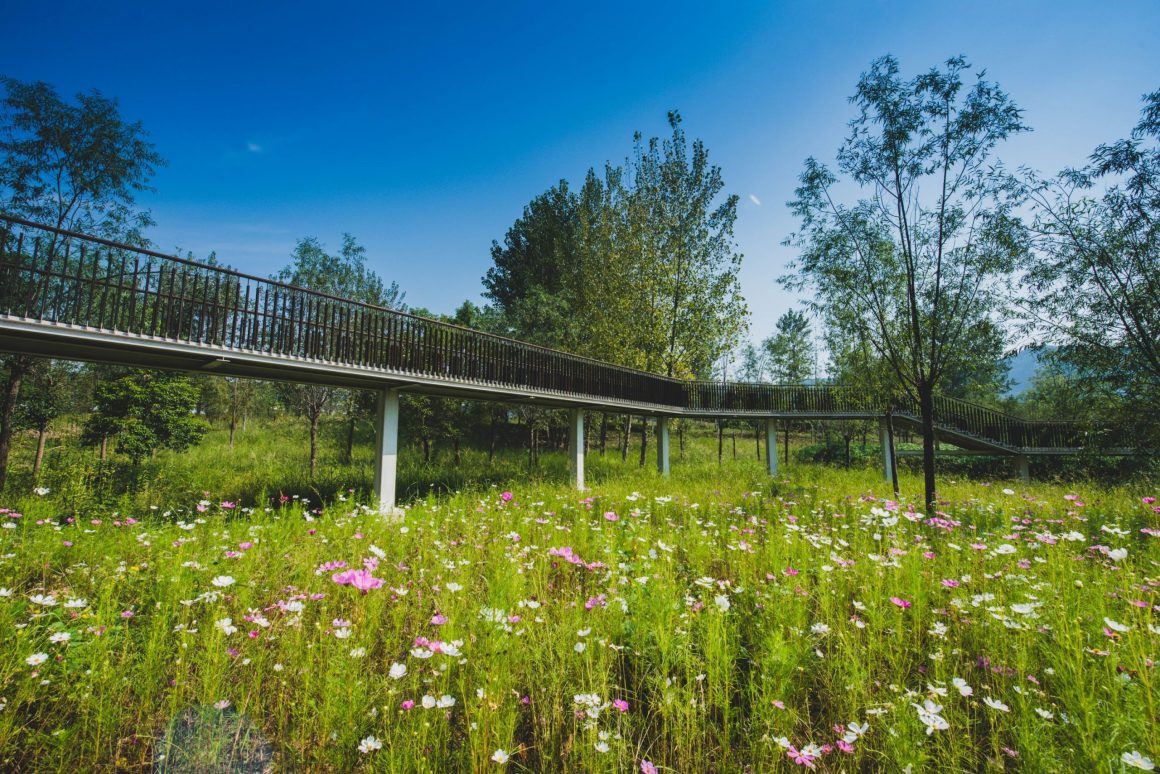
▽雨水花园种植多种耐水湿植物,生长繁茂 Rain garden planted a variety of water – resistant plants, luxuriant growth

▽原有挖沙遗留坑塘经过生态修复变身为湿地中最具生物多样性潜力的场所 The original pit left by sand-dredging has been transformed into a site with the greatest potential for biodiversity in wetlands through ecological restoration

项目启动后,已被纳入国家第三批山水林田湖草生态保护修复工程试点,并接连成为宜昌市和湖北省的生态保护修复示范工程。项目完成后,也迅速成为宜昌市民休闲郊游,健身娱乐和科普认知的重要场所,听得见水流淙淙,望得见池底游鱼,儿童在林间嬉戏,白鹭从头顶飞过,这也是本项目设计的初心。
After the project was launched, it has been included in the third batch of national pilot projects for ecological protection and restoration of mountains, rivers, forests, fields, lakes and grasses, and has successively become a demonstration project of ecological protection and restoration in Yichang City and Hubei Province. After the completion of the project, it has quickly become an important place for Yichang citizens to enjoy leisure outings, fitness entertainment and popular science awareness. You can hear the water gurgling, see fish swimming at the bottom of the pond, children playing in the forest, and egrets flying overhead. It is also the original intention of the design of this project.
▽湿地内部水系之间有高差,水流淙淙 There is a height difference between the internal water system of the wetland, and the water is murmuring

项目名称:宜昌黄柏河湿地公园
设计方:杭州园林设计院股份有限公司
公司网站:https://www.hzyly.com/
设计完成时间:2019年6月
项目竣工时间:2021年10月
主创及设计团队:张骞、杨钟亮、王昱、万长江、任梓帅、聂文彬、鲍侃袁、高海防、金爱雪、黄号、彭昌敏、毛建丽
项目地址:湖北省宜昌市夷陵区
项目面积:154公顷
摄影版权:张骞、王昱
甲方:湖北黄柏建设开发有限公司
Project name: Yichang Huangbai River Wetland Park
Design: Hangzhou Landscape Architecture Design Institute Co., Ltd.
Website: https://www.hzyly.com/
Design completion: June 2019
Project completion time: October 2021
Leader designer & Team: Zhang Qian, Yang Zhongliang, Wang Yu, Wan Changjiang, Ren zishuai, Nie wenbin, Bao Kan yuan, Gao Haifang, Jin Aixue, Huang Hao, Peng Changmin, Mao Jianli
Project location: Yiling District, Yichang City, Hubei Province
Project Area:154 ha
Photo credits : Zhang Qian, Wang Yu
Clients: Hubei Huangbai construction and Development Co., Ltd
“ 在减少对湿地的人为干预,恢复植被和生态的前提下,同时满足科普休闲观景的功能。 ”
审稿编辑 Ashley Jen
更多 Read more about: 杭州园林设计院股份有限公司




0 Comments